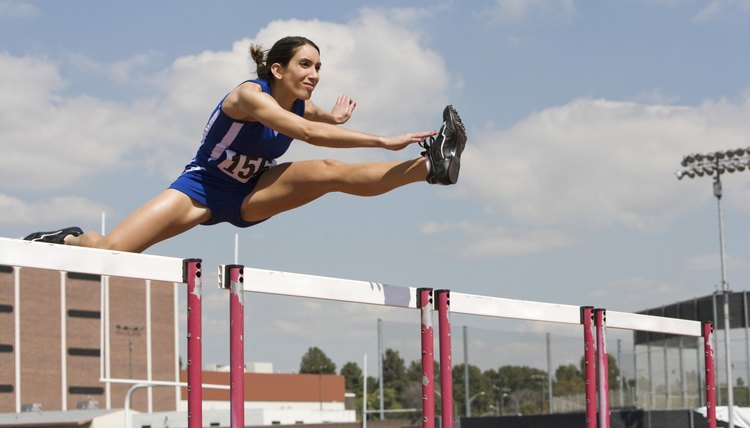What Is the History of Track and Field Hurdles?

Track and field hurdle events have a long history. The two major hurdle races for men appeared in the mid-19th century in England. Around 1830, hurdle races of 100 yards were run over heavy wooden barriers. The distance was extended to 110 meters in 1888. The elongated hurdle race at 400 meters was introduced around 1860 in Oxford. Runners jumped over 12 heavy wooden barriers that were spaced equal distances apart. The 110-meter hurdles were introduced as an Olympic Games race in 1896, just after the heavy, solid hurdles were replaced with lighter-weight hurdles that could be knocked over forwards. The 400-meter hurdles became an Olympic sport for men in 1900.
Women
The first women's hurdle races were run in 1926 over a distance of 80 meters. The event attained Olympic status in 1932. In 1969, the distance was extended to 100 meters, which became the standard at the Olympics beginning in 1972. Women didn't run the 400 meter hurdles at the Olympics until 1984.
Evolution
In the early days of the sport, hurdles were much more of a barrier than in the 21st century. Because you couldn't "run through" the hurdles and knock them over -- the stationary, heavy hurdle was more likely to knock over the runner -- early technique was primitive. Competitors executed "bundled" jumps by tucking their legs under their bodies. Even when lighter hurdles were introduced, you were disqualified if you knocked over more than three hurdles, a rule that prevailed until the L-shaped hurdle was introduced in 1935. Gliding over hurdles then became the modern hurdling technique, and when synthetic running tracks became standard in the 1960s, records were regularly shattered.
Male Champions
The first great male hurdler was an American, Alvin Kraenzlein, who created the modern technique of striding instead of jumping over hurdles while taking three steps between barriers in the 110-meter hurdles. Other Americans have dominated in this event. In the 1948 and 1952 Olympic Games, held in London and Helsinki, Harrison Dillard established an unprecedented record by winning gold medals in both the 100-meter dash and the 110-meter hurdles. In the 400-meter hurdles, Edwin Moses, considered the best long-distance hurdler in history, won 122 consecutive races between 1977 and 1987, including gold medals in 1976 and 1984. As of January 2014, the world-record holder in the 400 meter hurdles is Kevin Young, who blazed over the track in 46.78 seconds at the 1992 Olympics.
Female Champions
Babe Didrikson Zaharias, voted the best woman athlete in the world from 1900 to 1950 by the Associated Press, won the inaugural 80-meter hurdles for women at the 1932 Olympic Games in world record time. Other famous champions made their mark in the modern era in the 400-meter hurdles. In the inaugural Olympic race for women in 1984, Nawal El Montawake became both the first African woman and the first Islamic woman to capture the gold. In 1992, Britain's Sally Gunnel became the only woman to simultaneously hold the Olympic, world European and British Commonwealth championships in a single event. The world record for women in the 400-meter hurdles is held by Russian star Yulina Pechonkina at 52.32 seconds.
References
Writer Bio
Jim Thomas has been a freelance writer since 1978. He wrote a book about professional golfers and has written magazine articles about sports, politics, legal issues, travel and business for national and Northwest publications. He received a Juris Doctor from Duke Law School and a Bachelor of Science in political science from Whitman College.
